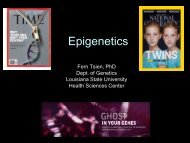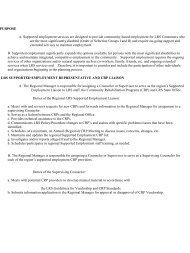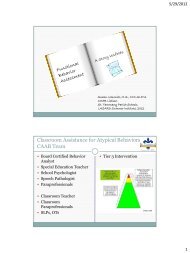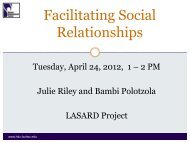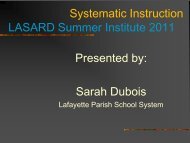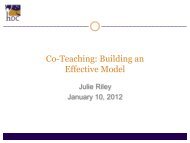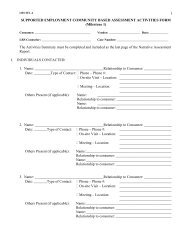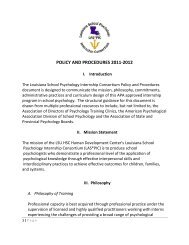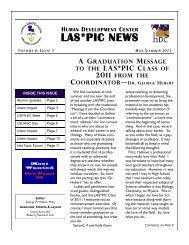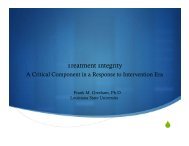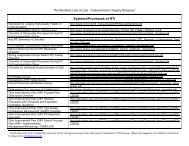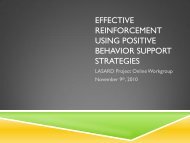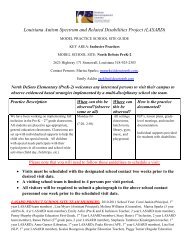Balanced Literacy for Students with Autism and other Significant ...
Balanced Literacy for Students with Autism and other Significant ...
Balanced Literacy for Students with Autism and other Significant ...
Create successful ePaper yourself
Turn your PDF publications into a flip-book with our unique Google optimized e-Paper software.
<strong>Balanced</strong> <strong>Literacy</strong> <strong>for</strong> <strong>Students</strong><strong>with</strong> <strong>Autism</strong> <strong>and</strong> <strong>other</strong><strong>Significant</strong> DisabilitiesChristi CarnahanChristi.carnahan@uc.edu
OverviewProvide a framework <strong>for</strong> designing balanced literacyinstruction <strong>for</strong> individuals <strong>with</strong> significant needsDiscuss strategies <strong>for</strong> incorporating a variety oftechnologies as the foundation <strong>for</strong> building dailyliteracy experiences.
Reading <strong>and</strong> Writing as Communication“For all children to become members of their literatecommunities, we must consider reading <strong>and</strong> writing not as endproducts but rather as socially constructed communicativepractices that begin to emerge early in childhood as <strong>other</strong>communicative abilities do. Both oral <strong>and</strong> written language arethus best viewed as primarily communicative practices, <strong>and</strong> anintervention to achieve that end is best viewed as situatedpractice. Consequently, to support emergent literacydevelopment, we want to consider… the social, functional,physical, <strong>and</strong> emotional contexts of the literacy event so thatboth oral <strong>and</strong> written communication <strong>and</strong> languagedevelopment can be focused upon” (Kaderavek & Rabidoux,2004, p.239)
Food <strong>for</strong> thoughthttp://www.youtube.com/watch?v=Vib2__BDCXc&feature=recentfhttp://www.youtube.com/watch?v=yvvT_yrImHQ
Interactive to Independent <strong>Literacy</strong>(Kaderavek & Rabidoux, 2004)1 Focus on joint attention <strong>and</strong> response/engagement in literacy activities <strong>with</strong> a partner.Onus <strong>for</strong> building engagement is on the partner.Begin <strong>with</strong> individual’s interests.2 Focus on mutual interactions <strong>and</strong> turn taking between the emergent learner <strong>and</strong> theliteracy partner; high levels of rein<strong>for</strong>cement while participating in a variety of literacyinteractions.The partner builds on the individual’s gestures, vocalizations, words, etc..If the teacher asks the child to engage in skills “beyond the child’s interest or ability,then the balance <strong>and</strong> the dynamic social support of the interaction may be lost” (p. 246).3 The individual begins to underst<strong>and</strong> the “symbolic relationship of written language<strong>for</strong>ms” (p. 246).For example, they begin to that the printed text corresponds <strong>with</strong> the words the partnerreads.4 The learner begins to use conventional literacy skills <strong>with</strong> support.5 The learner independently uses conventional literacy.
<strong>Autism</strong> <strong>and</strong> ReadingComprehensionToMEFWCC
Reading Profiles in HighFunctioning ASDForms a text base.Little in the way of asituation model.Text BoundStrategicConstructs a highlyaccurate text base <strong>and</strong>a mostly relevantsituation modelConstructs a highlysubjective situationmodel often <strong>with</strong>outregard to the text baseImaginative
Text Bound Comprehension, LeslieL: (reading) Adults played hide <strong>and</strong> seek when winter was over.People were tired of the cold. They wanted to know if springwas on the way.C: Alright. So, if you could tell me what you’re thinkingabout. You can use your words or write it down or draw apicture.L: Spring was on the way.C: (paraphrases answer) Anything else you’re thinking aboutas you were reading?L: Adults <strong>and</strong> children playing hide <strong>and</strong> seekWilliamson et al., 2009; Carnahan et al., 2009
High Functioning Comprehension, MarkMany children like to play “hide <strong>and</strong> seek.”Hide <strong>and</strong> seek did not begin as a game.It started many years ago in a far away l<strong>and</strong>.C: Yeah. So what are you thinking about?M: What year did hide <strong>and</strong> seek begin?C: What makes you ask that question?M: Many years ago. What year? In the 1600s?C: I don’t know. That’s an excellent question. I couldprobably find out on Google.M: Yeah. Hide <strong>and</strong> Seek did not begin as a game.It started…C: Okay. Stop right there. What are you thinkingabout now?M: I was reading my mind. It began many yearsago.C: You are not just reading that in your mind. You arereading that on the paper too. It’s hard to just read itby sentence isn’t it. Go ahead read that last sentence.M: It started years ago in a far away l<strong>and</strong>.C: Okay. So now tell me what you’re thinking about.M: Hide <strong>and</strong> seek. It started in a l<strong>and</strong>. What’s [thel<strong>and</strong>’s] name?Carnahan et al., in press; Williamson et al., 2009
Imaginative Comprehension, IanThe owl was scared.He could not play.He could not eat.He could not find his sister.He looked in the bush.He looked in the creekHe looked in the tree.He found her!Owl is happy.Williamson et al., 2009; Carnahan et al., 2009
Text Bound ComprehenderInstructional goalsFacilitate accurate construction of text modelFacilitate construction of situation model throughactivation of relevant background knowledgeInstructional strategiesTrack referents, sentence by sentence (e.g., Molly wentto the grocery. She bought c<strong>and</strong>y there.)T+B=I inference machinesPersonal connection stories
Strategic ComprehenderSupport continued accurate construction of text baseContinued exposure to new content <strong>and</strong> ideasBuild bridges through connections to favored topics oracademic primingStrengthen selection of relevant knowledge-basedinferences (text-to-text, text-to-self, text-to-world)
Imaginative ComprehenderFocus on facilitating accurate construction of text baseWork on building local inferencesWork on building knowledge of story grammar <strong>and</strong> textstructure
What is a <strong>Balanced</strong> <strong>Literacy</strong>Approach?Holistic <strong>and</strong> explicit instructionIncorporates a selection of strategies from the best theoriesavailableNot one size fits all or one approach fits allThematic instruction based on student interests <strong>and</strong> experiencesBuilds on existing background knowledgeFrequent, organized access to materials that align <strong>with</strong> studentneedBuilds emergent literacy skills, but goes beyond emergent literacyskills
A <strong>Balanced</strong> <strong>Literacy</strong> ApproachDaily reading, work <strong>with</strong> words, <strong>and</strong> writingConnected instructionReading (reading as thinking; focus on comprehensionthrough teacher <strong>and</strong> student selected materials, <strong>and</strong> readingaloud <strong>and</strong> silent reading)Writing (focus on generating ideas <strong>with</strong>out mechanics as abarrier)Working <strong>with</strong> words (focus on word instruction that movesfrom concept development to analyzing words <strong>and</strong> wordparts)Support activation of background knowledge, students’abilities to make connections between texts, <strong>and</strong> incorporatein<strong>for</strong>mation from both the text <strong>and</strong> their own knowledge tobuild comprehension
<strong>Balanced</strong> <strong>Literacy</strong> InstructionBuilding Blocks(Hall &Williams)http://www.four-blocks.com/kindergarten.htmDaily Reading, Writing, <strong>and</strong> Word Study*Student selected*Teacher selected*Focus on meaning<strong>and</strong> buildingcomprehension*Connected toreading*Focus ongeneration, notmechanics*Concepts, spellingpatterns, <strong>and</strong> inbetween*teach skills incontext to supportreading <strong>and</strong> writingBalance explicit <strong>and</strong> holistic instruction
Let’s Explore Reading
Reading InstructionCombines both teacher selected <strong>and</strong> student selected materialsIncludes daily engagement in silent reading, teacher read alouds,partner reading, etc.Includes attention to both specific skills <strong>and</strong> larger processesIncorporates a variety of technologies to promote studentsuccess
Making Text Available <strong>for</strong> ALL Learners• Determine the purpose (e.g., silent reading or guided)• Adapt the materials (It doesn’t always have to be high tech)• Adapted books– PowerPoint Books <strong>and</strong> <strong>other</strong> Talking Books– Tactile books– Online books– Write your own books (big books, LE books, etc.)– Embed music <strong>and</strong> interactive materials• Text to Speech/Speech to Text Software
Engaging Learners <strong>with</strong> the Text• Language Experience Approach• Reader’s Workshop• Shared reading• Partner Reading• Guided Reading• Each activity includes– Be<strong>for</strong>e reading activities– During reading activities– After reading activities
Small Group InstructionalFramework1. Be<strong>for</strong>e reading activitiesActivate (relevant) background knowledgeDefine a purpose <strong>for</strong> readingMake initial predictions about the textConcept <strong>and</strong>/or vocabulary introduction2. During reading activitiesMake text connectionsSelf monitor (accuracy <strong>and</strong> errors)Make inferences (word, sentence, paragraph, <strong>and</strong> story level inferences)3. After reading activitiesConfirm that the purpose <strong>for</strong> reading was metEnsure that underst<strong>and</strong>ing is in line <strong>with</strong> the textContinue to make text connections <strong>and</strong> link/integrate new <strong>and</strong> previousknowledge
Guiding Questions <strong>for</strong> Selecting Be<strong>for</strong>e,During, <strong>and</strong> After Reading Activities1. What are the important concepts that the student must underst<strong>and</strong> tocomprehend the story?• Knowledge of character states• Knowledge of topics2. What are the key vocabulary words?• Clarifying multiple meanings of words• New words being introduced3. Language considerations• Idioms, similes, metaphors4. What is the background knowledge base from which the students willdraw?• Life experiences, <strong>other</strong> text, world knowledge• Based on your knowledge of the student, what relevant experiences doesthe student bring to support underst<strong>and</strong> the story?• Are there any tangentially related experiences that will distract fromunderst<strong>and</strong>ing (e.g., special interests)
Guiding Questions <strong>for</strong> Selecting Be<strong>for</strong>e,During, <strong>and</strong> After Reading Activities5. What is my purpose in selecting the book?• Consider the purpose <strong>for</strong> selecting different kinds of books6. At what text level does the child comprehend• Word, sentence, paragraph, chapter, <strong>and</strong> story7. How will you facilitate knowledge integration?• How will you support text to self, text to text, <strong>and</strong> text to selfconnections?
PowerPoint BooksHow to make a PP Bookhttp://atto.buffalo.edu/registered/Tutorials/talkingBooks/powerpoint.phpPowerPoint Books – A Few ExamplesLEA PP BookExpository - http://tarheelreader.org/category/booktype/type-conventional/Narrative – Tricky Tracy
Tactile BooksStrategies <strong>for</strong> making tactile bookshttp://www.med.unc.edu/ahs/clds/resources/tactual-book-kitdirectionsTactile Books – A Few Examples
Online Books•Tar Heel Readerhttp://tarheelreader.org/category/booktype/type-conventional/• Storyline Onlinehttp://www.storylineonline.net/•Storyplacehttp://www.storyplace.org/•TumbleBook Library (NY PL)http://www.tumblebooks.com/library/asp/home_tumblebooks.asp
Write Your Own BooksResources <strong>for</strong> writing your own booksFrequently based in LEAAppropriate across the agesLearners or teachers can type, dictate, or record textCan be adapted to incorporate videos, recorded music, etc.Can incorporate patterns, etc.Creating class pattern books -http://www.readwritethink.org/lessons/lesson_view.asp?id=1010Write Your Own Books – A Few ExamplesReading Group Wildwood
Embed Music <strong>and</strong>/or Interactive PiecesCreating interactive booksPurchase texts <strong>with</strong> existing music <strong>and</strong> add interactive piecesWrite your own text to a familiar tune,add interactive pieces, solicit help to addmusic
Interactive Books
Solo <strong>Literacy</strong> Suite• KurzweilTech Tools(Text to Speech, etc.)http://www.donjohnston.com/products/solo/CoWriterREAD OutloudWRITE OutloudDRAFT Builder• http://www.kurzweiledu.com/default.aspx• IntelliTools• http://store.mayer-johnson.com/us/intellitools-classroom-suite-v-4.html?ctt_id=6992549&ctt_adnw=Google&ctt_kw=intellitools&ctt_ch=ps&ctt_entity=tc&ctt_adid=4003429022&ctt_nwtype=search&ctt_cli=2x10088x46442x1220044&gclid=CMbKvfn4mJ4CFU1M5Qod_08YsQ
ExampleTheme: Living <strong>and</strong> Nonliving1. Identify the big ideas• Who will learn what (concepts <strong>and</strong>goals/objectives)?• How will they learn it?• How will they show what they know?2. Reading• Set the theme <strong>with</strong> entire group or class• Every student engages in different kindsof reading each day (silent reading,listening to <strong>other</strong>s read, etc,)
Living <strong>and</strong> Non-Living: Setting theThemePrime new theme <strong>for</strong> students <strong>for</strong> whom this may beappropriate (reading a book at home, indicating topicchange visually on the calendar, etc.)Living <strong>and</strong> Non-Living Things Videohttp://www.youtube.com/watch?v=lB0WF6P7sSk&NR=1http://www.youtube.com/watch?v=9laQwaKOW8s&feature=relatedhttp://www.youtube.com/watch?v=PZ2FI50oecs&feature=relatedIntroduce new vocabularyNon-LivingRead aloud incorporating B-D-A strategiesliving
Selected Text: Living <strong>and</strong> Non-Living
Living <strong>and</strong> Non-Living Scavenger HuntSmall groups or individual studentsCan physically obtain items or take pictures of the itemsCan be assigned to find specific items (matching) or asked tofind a specific number of each item
Living <strong>and</strong> Non-Living Scavenger HuntFind:Find Four Items1.LivingCRC2.Living3.Non-living4.Non-living
Let’s Explore Word Study
Working <strong>with</strong> Words• What is word work <strong>for</strong> students <strong>with</strong> significant disabilities?– Concepts, vocabulary, building interest in words– Language concepts– Phonemic awareness– Sight words– Phonics instruction based upon student needs (segmenting,blending, word families/patterns, etc)– For students <strong>with</strong> significant/complex needs it can beconceptual <strong>and</strong> should ALWAYS be contextualized• Concept word sorts (categories)• You may need to explicitly teach– Skills such as matching <strong>and</strong> sorting– Concepts <strong>and</strong> pictures (single objects, building to the larger feature,function, or class)
Teaching Activities• Meaning making… the primary reason <strong>for</strong> word work is to supportcomprehension <strong>and</strong> writing– Concept sorts– Word sorts– Phonics as appropriate– Build the concept to teach the vocabulary to create the context• Make it visual• Make it interactive• Make it engaging
Developing Core WordsWhy core words?The most successful systems are “are word based <strong>with</strong>keyboard access” rather than phrase based systems (Grether &Pelatti, 2010)What are word based systems?Single words <strong>and</strong> word partsWords are categorized by syntactically (e.g., question words,pronouns, verbs, adjectives, adverbs, object words) orsemantically (e.g., foods, places, people)Provide access to tense, plurality, possession, <strong>and</strong> adverbmarkers
Developing Core WordsTeaching core wordsAided language stimulationSemantic webbing (identifying features of a word that help inlocating the wordsThings Vehicles TrainTractorProvide access to the keyboard <strong>for</strong> segmenting, blending, <strong>and</strong>nonsense words by copying or independent generationSee the Core Words h<strong>and</strong>out from QLI (2010)
Autobiography: Working <strong>with</strong> WordsAuto(self)bio(life)graph(write)
Autobiography: Working <strong>with</strong> Words
Let’s Explore Writing
Factors that Affect <strong>Students</strong>’ Writing SkillsLearning differences (e.g., problems <strong>with</strong> workingmemory)Lack of opportunities to develop writing skillsInappropriate literacy instruction (e.g., limited torecognizing sight words)Underlying language problems (e.g., limitedvocabulary, incomplete underst<strong>and</strong>ing of grammar)Limited knowledge of phonics that affect abilities tospell words
Importance of Writing Daily• It’s functional <strong>and</strong> authentic• Deepens underst<strong>and</strong>ing of language– Encoding vs. decoding• It’s engaging <strong>and</strong> fun• Assessment – it tells teachers what students underst<strong>and</strong> about print– Knowledge of sound/symbol correspondences (phonics)– Knowledge of language structure (syntax <strong>and</strong> grammar)– Knowledge of mechanics– Knowledge of vocabulary– Fine motor skill <strong>and</strong> writing fluency
Developmental Stages of WritingScribblingLetter-like symbolsStrings of lettersBeginning sounds emergeConsonants represent wordsInitial, middle, <strong>and</strong> final soundsTransitional phrasesSt<strong>and</strong>ard spelling
Big Ideas: Teaching Writing• It’s all about meaning• High expectations– Your students have important ideas to communicate– Provide rich experiences that motivate them to want tocommunicate their ideas, thoughts, <strong>and</strong> impressions– Provide daily opportunities to write• It’s the only way these skills will be developed• Combine direct instruction <strong>with</strong> the process of writing• The mechanics should not get in the way of generation!
Specific StrategiesNatural writing embedded across the dayLanguage Experience ApproachShared writingGuided writingEach activity includes the steps in the writing process.
Writing Process• Discursive• Motivation <strong>for</strong> writing– Purpose– Choice– Stimulating topics• Phases of writing process– Planning– Writing– Revising– Publishing
Writing <strong>for</strong> <strong>Students</strong> <strong>with</strong> <strong>Significant</strong>DisabilitiesWriting activities includeTraditional writing tools whenever possibleAdapted writing toolsOpportunities to compose using pictures, fill in,matching, dictating, etc.Explicit teaching related to both mechanics <strong>and</strong>composition/generation
Tool: Co:Writer(Don Johnston)From: http://www.inclusive.co.uk/catalogue/acatalog/co_writer_se.html
Tool: Alternative Pencil(from Write from the Start… With an Alternative Pencil, Hanser, 2004)http://www.med.unc.edu/ahs/clds/available-<strong>for</strong>-purchase-1/available-<strong>for</strong>purchaseALPHABET EYE GAZE FRAMES: Includes different eye gaze frame setups that use colored cards,colored letters, or black/white cards.PRINT FLIP CHARTS: flip charts that have high contrast colored letters <strong>and</strong> backgrounds,BRAILLE ALPHABET FLIP CHART: Includes directions <strong>for</strong> making supplemental tactual symbolsCUSTOM ALPHABET INTELLIKEYS OVERLAYS: Overlays can be tactualized <strong>and</strong>/or brailledSWITCH ACCESSIBLE ONSCREEN
Building Narrativehttp://www.symbolsinclusionproject.org/symbols/every_child_matters/safe.htm
Generating about My Dayhttp://www.cricksoft.com/UK/products/clicker/clicker_grids.htm
Questions



